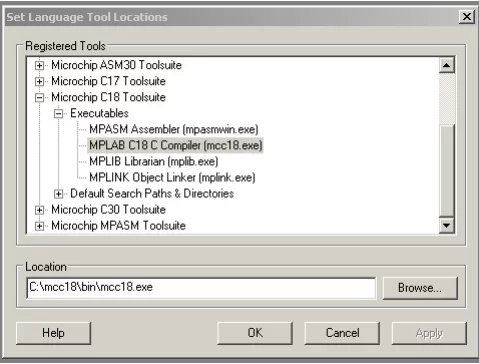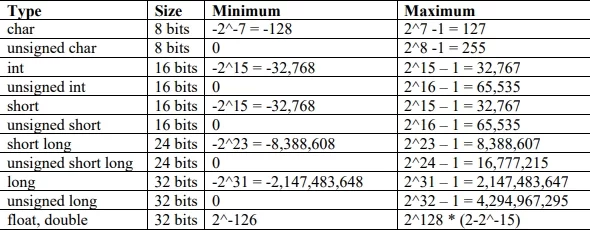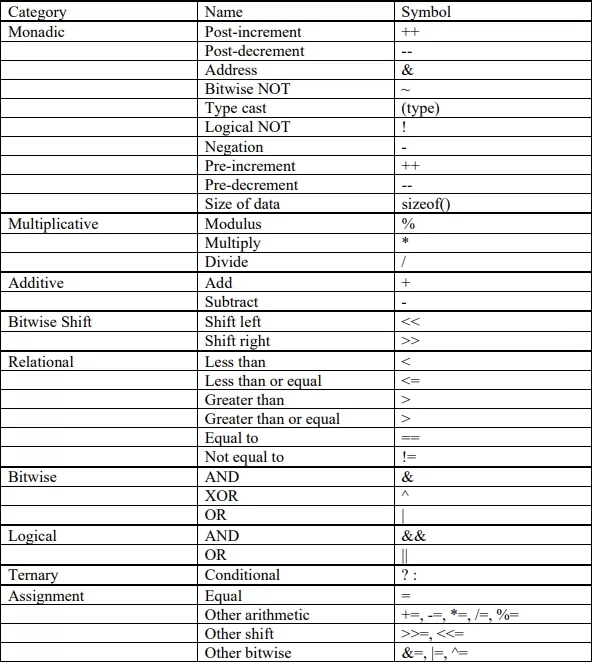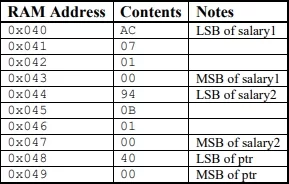This guide introduces C programming with emphasis on the PIC C compiler. It assumes
familiarity with another high-level programming language such as Java. Parts of this
tutorial are adapted from Nathaniel Pinckney’s C Microtoys tutorial. More information is
available in the Microchip MPLAB C18 C Compiler manuals.
Using the MPLAB C Compiler
You must configure MPLAB with the locations of the C18 programs. The C18 compiler
should already be installed in the directory C:\mcc18. To configure MPLAB with the
locations of the C18 programs, first go go to the Project Menu Æ Set Language
Tool Locations… In the dialog that appears, under Registered Tools expand
Microchip C18 Toolsuite and set Executables Æ MPLAB C18 C
Compiler (mcc18.exe) location to C:\mcc18\bin\mcc18.exe, as shown in
Figure 1. Next, expand Default Search Paths & Directories, set
Library Search path, $(LIBDIR)’s location to C:\mcc18\lib and
Linker-Script Search Path, $(LKRDIR)’s location to C:\mcc18\lkr.
Lastly, click OK to close the dialog box and save the changes.

Next, you want to create a project to use the C18 compiler. Select Project Æ New
and enter a suitable name and location for your project. Note that MPLAB is picky about
project names and locations. You must preface the location with a drive letter; the \\server notation for remote directories is not supported. After creating the project, set the project toolsuite to C18, go to Project Æ Select Language Toolsuite. Change Active Toolset to Microchip C18 Toolsuite. Verify that all of the Toolsuite Contents values have associated Locations. Click OK. Next, go to Build Options… Æ Project and click the button Suite Defaults. (Multiple people have overlooked this step, to their chagrin.) The Library and LinkerScript paths should automatically be set from the values you entered earlier. Click OK. Projects can have multiple source files. When compiling, C source files (.c) are translated and assembled into object files (.o), after which a linker combines the object files into a single binary file (.cof), suitable for programming onto a PIC’s EEPROM. To create a new source file go to File Æ New. Save the file by selecting File Æ Save As…, navigating to the project’s directory, entering a filename ending in .c, and clicking Save. Lastly, add the file to the project by right-clicking on Source Files in the project window and selecting Add Files… Be sure to begin your C source file with #include to be able to access common named special function registers, which will be discussed later. Lastly, you must specify a linker script for the PIC you are using. Linker scripts are PIC specific and are used to generate an appropriate binary data image for the PIC you are using. Right-click on Linker Scripts in the project window and select Add Files… Navigate and select C:\mcc18\lkr\18f452.lkr as the linker script.
A Test Program
Try out the compiler using a simple test program: /* ledtest.c */ #include void main(void) { TRISD=0; PORTD=0x4A; } Build All, and then use the debugger to test the code in simulation and on your PIC. When you single step through, note that the C compiler adds some initialization code before it jumps to your main function. If Build All complains that it can’t find files such as c018i.o, clib.lib, or p18f452.lib, then you probably neglected to click Suite Defaults.
Data Types
C has a number of built-in data types available. The size of each primitive data type,
except pointers which are covered later, along with the minimum and maximum numeric
values, is shown in Table 1. Unless declared with the qualifier unsigned, data types are
signed (can hold positive and negative values) by default. Remember that the 18F452 is
an 8-bit microcontroller. Using data types of more than 8-bits takes multiple instructions,
so use 8-bit data types (char or unsigned char) where possible. Double-precision floating
point numbers do not comply with the IEEE standard 64-bit size, but instead are identical
to 32-bit floats. When byte-addressing data types, keep in mind that data on the PIC is
stored in little endian format (the least-significant byte is stored at a lower address in
memory than the most-significant byte). It is good practice to isolate code that depends
on byte-ordering in memory, to make porting to other platforms easier.

Since PIC’s are very limited in data memory, economical use of data memory is
important. The PIC18F452 includes more program memory (32KB) than data memory
(1.75KB), therefore the compiler defaults to storing constants, including string constants,
in program memory.
Variables must be declared at the beginning of a function. They can be initialized as part
of their declaration.
Comments
Comments can begin with /* and end with /. They can span multiple lines. Comments can also begin with // and terminate at the end of the line. // this is an example of a one-line comment. / this is an example
Of a multi-line comment */
Operators
C supports the following operators. They are listed by category in order of precedence.
For example, multiplication operators take precedence over addition operators. Within
the same category, operators are evaluated in the order that they appear in the program.

Global and Local Variables
A global variable is declared outside of all the functions (normally at the top of a
program). It can be accessed by all functions. A local variable is declared inside a
function and can only be used by that function. Therefore, two functions could have
local variables with the same names without interfering with each other. Use global
variables sparingly because they make large programs more difficult to read.
Language Constructs
If//else
int bigger(int a, int b)
{
if (a > b) return a;
else return b;
}
While loops
void main(void) { int i = 0, sum = 0; // add the numbers from 0 to 9 while (i < 10) { // while loops check condition before executing body sum = sum + i; i++; } }
Do loops
void main(void) { int i = 0, sum = 0; // add the numbers from 0 to 9 do { sum = sum + i; i++; } while (i < 10); // do loops check condition after executing body }
For loops
void main(void) { int i; int sum = 0; // add the numbers from 0 to 9 for (i=0; i<10; i++) { sum += i; } }
Pointers
A pointer is the address of a variable. Normally, pointers used in PIC programming are
16-bit numbers specifying an address in RAM or ROM.
For example, suppose you declare the following variables:
unsigned long salary1, salary2; // 32-bit numbers
unsigned long ptr; / a 16-bit pointer specifying the address of an
unsigned long variable */
The compiler will assign arbitrary locations in RAM for these variables. For the sake of
concreteness, suppose salary1 is at addresses 0x40-43, salary2 is at addresses
0x44-47 and ptr is at 0x48-49.
In a variable declaration, a * before a variable name indicates that the variable is a pointer
to the declared type. In a variable use, the * operator dereferences a pointer, returning the
value at the given address. The & operator is read “address of,” giving the address of the
variable being referenced.
salary1 = 67500; // assign salary1 to be $67500 = 0x000107AC
ptr = &salary1; // assign ptr to be 0x0040, the address of salary1
salary2 = ptr + 1000; / dereference ptr to give the contents of address 40 =
67500, then add $1000 and set salary2 to $68500 */
The C18 compiler uses little-endian data storage, so the least significant byte of a multibyte variable is stored at the lowest address. Thus, at the end of this program, the
memory contains:

The C18 compiler supports a few qualifiers for pointers. Since memory on a PIC is not
in a flat-addressing space, but split between program ROM and data RAM, a pointer must
be labeled as either rom or ram, the two types are not compatible. Additionally, there are
two sizes of pointers available, near and far. Near is a pointer within the first 64KB of
ROM or in access RAM (i.e. a bank switch is not required). Far refers to any location in
RAM or ROM. Since the PIC18F452 only includes 32KB of program memory, only a
near rom pointer is needed to access a location in program memory. By default a pointer
is a far ram pointer. Ram pointers are always 16-bits in size. Near rom pointers are 16-
bits in size and far rom pointers are 24-bits in size.
Arrays
An array is a group of variables stored in consecutive addresses in memory. The
elements are numbered starting at 0. In C, the array is referred to by the address of the 0th
element. It is the programmer’s responsibility not to access elements beyond the end of
the array; the code will compile fine, but will stomp on other parts of memory.
When an array is declared, the length should be defined so that the compiler can allocate
memory. When the array is passed to a function, the length need not be defined because
the function only cares about the address of the first entry.
In the following example, suppose we have an array indicating how many wombats
crossed the road each hour for each of the past 10 hours. Suppose the 0th element is
stored at address 0x20.
int wombats[10]; // array of 10 2-byte quantities stored at 0x20-0x33.
int *wombptr; // a pointer to an integer
wombats[0] = 342; // store 342 in addresses 0x20-21
wombats[1] = 9; // store 9 in addresses 0x22-23
wombptr = &wombats[0]; // wombptr = 0x020
*(wombptr+4) = 7; /* offset of 4 elements, or 8 bytes. Thus addresses 0x28-29 = 7,
so this is another way to write wombats[4] = 7. */
The last example shows that *(array+k) is equivalent to array[k]. int sort(int *vals, int numvals) // no need to declare the size of vals explicitly { int i, j, temp; for (i=0; i vals[j]) { temp = vals[i]; vals[i] = vals[j]; vals[j] = temp; } } } }
By default, data structures stored in RAM cannot exceed one page (256 bytes). This is a
problem for things like large arrays. See page 104 of the C Compiler Getting Started
manual for how to override this.
Arrays of constants stored in program memory should be declared as rom (e.g. rom int
notes[] = {0x1234, 0x5678, …};). This avoids the one page limitation for
RAM arrays.
Characters
A character is an 8-bit variable. It can be viewed either as a number between -128 and
127 or as an ASCII code for a letter, digit, symbol, or so forth. Characters can be
specified as a numeric value (in decimal, hexadecimal, etc.), or as a printable character
enclosed in single quotes.
For example, the letter A has the ASCII code 0x41, B=0x42, etc. Thus ‘A ‘ + 3 is
0x44, or ‘D’.
Special characters include:
‘\r’: carriage return (when you press the enter key)
‘\n’: new line
‘\t’: tab
Most C environments use \n alone to go to the beginning of a new line. However, some
terminals expect both \n and \r to advance to the beginning of the next line. In particular,
the PIC should send both characters when writing to a HyperTerm terminal.
The character 0 is called the null character. It terminates a string.
Strings
A string is an array of characters. Each character is a byte representing the ASCII code
for that letter, number, or symbol. The array has a size, specifying the maximum length
of the string, but the actual length of the string could be shorter. In C, the length of the
string is determined by looking for a NULL character (0x00) at the end of the string.
void strcpy(char *src, char *dst)
{
int i = 0;
do {
dst[i] = src[i]; // copy characters one byte at a time
} while (src[i++] != NULL); // until the NULL terminator is found
}
Inline Assembly
Occasionally you might want to include assembly code in parts of your program. It is
possible with the C18 compiler to include inline assembly, but you should use it
sparingly as the compiler will not optimize your code. Begin a block of assembly code
with _asm and end with _endasm.
The syntax inline assembly code is similar to the MPLAB assembler, with some
differences:
• No assembler directive support
• Comments should be in C notation – // instead of ;
• No default values for operands – Optional operands such as d (controls to/from
WREG) for movf (and others) are required to be specified.
• Literals must use C radix notation – For hex, 0xABCD and not h’ABCD’.
• Labels must include colons – Always include : in label:
An example of calling a C function from inline assembly is given in the interrupts
section.
Direct Hardware Access
You may access most special function registers, by the names given in the PIC’s
datasheet, by including the header file “p18f452.h”. Some registers are included in other
header files, for example, timer registers (TMR0, T0CON, etc) are in “timers.h”.
Individual bits of a special function register may be accessed through a C structure named
by appending “bits” to the special function register’s name. The individual bits share the
name given in the PIC’s datasheet. For example, all of INTCON, the interrupt control
register, may be accessed (as an unsigned char) by just using “INTCON” or individual
bits may be accessed (as boolean variables) like INTCONbits.TMR0IF.
TRISD = 0;
PORTD = 0xA5; // turn on four of the LEDs
Libraries
The C18 compiler comes bundled with C libraries to make a PIC programmer’s life
easier. Refer to the MPLAB C18 C Compiler Libraries manual for information about the
different library functions included with C18; they would not all fit in this
documentation. Header files might need to be included depending on what functions you
are using. A sampling of the categories of functions included:
• Basic PIC features: A/D Converter, Input Capture, I2
C, I/O Port, Microwire,
Pulse-Width Modulation, SPI, Timer, USART.
• External LCD
• Data Conversion – Including string to integer conversions, pseudo-random
number generation, lower/upper-case ASCII conversion.
• Memory and String Manipulation – Copy data from different memory locations,
compare strings, determine length of strings, tokenize strings, etc.
• Delay Functions
• Reset Functions – Determine if reset was caused by a brown-out, low voltage,
MCLR pin, watchdog timer, or wake-up.
• Character Output – printf, fprintf, putc, and other conventional string and
character output functions.
• 32-bit Floating Point – Routines implementing functions to manipulate IEEE-754
floating point numbers.
• C Standard Library Math Functions – sin, cos, log, sqrt, and much more.
printf Statements
The printf statement normally displays to a console. The PIC doesn’t have a screen
attached, so it instead sends characters over the serial port. If the serial port is properly
connected to a PC running a terminal program such as HyperTerm, printf will display the
text in the terminal window.
To make this connection, the PIC USART must be configured for serial output at a
specific baud rate with no parity. Write to the appropriate registers to do this
configuration. The PIC can connect to a PC over a serial cable or wireless link. To drive
a serial cable, a 3.3-V compatible RS232 transceiver is required to change the voltage
levels to the RS232 standard (+/- 5-15 V). Lab 6 explains how to connect wirelessly
using a BlueSMiRF module attached to the PIC and a Bluetooth dongle on a PC.
printf takes a string containing text and optional commands to print variables. For
example,
#include int num = 42; printf(“The answer to the ultimate question about life, the universe, and everything is %d\r\n”, num); %d tells printf to print the next variable as an integer (in decimal). printf requires the stdio.h library. More formatting commands are described in the PIC libraries manual. Unfortunately, the library does not support printing floating point variables. The C18 compiler gives a warning when the string is provided directly in the printf statement, but generates correct code anyway. The warning can be circumvented by defining the string separately: #include int num = 42; char fmtstr[] = “The answer is %d\r\n”; printf(fmtstr, num);
Interrupts
/* example of using a timer interrupt */
#include
void main(void);
void isr(void);
// The #pragma tells the compiler to start a code section, named
// high_vector at the program memory address of 0x08. This is the
// interrupt vector address.
#pragma code high_vector = 0x08
void high_interrupt(void) {
_asm
GOTO isr
_endasm
}
// Now start the main code section.
#pragma code
void main(void) {
// Set up timer interrupt
T0CON = 0xC0; // Timer on. 8-bit.
INTCON = 0xA0; // Enable interrupts. Interrupt on TMR0 overflow.
while(1) {
// do stuff that should normally happen
}
}
// The #pragma lets compiler know isr() is an interrupt
// handler. The compiled code will return correctly
// (with retfie instead of retlw) and save registers.
#pragma interrupt isr
void isr(void) {
INTCONbits.TMR0IF = 0; // clear interrupt flag
// do stuff that should happen when the interrupt occurs
Example
/* lab4.c: Implements E155 Lab 4 in C.
* Author: Nathaniel Pinckney
* Date: March 2005
*/
#include
#define SORT_NUM 12
/* Function Prototypes */
void main(void);
char findmax(char []);
void sort(char sortarr[]);
char maxarr[FINDMAX_NUM] = {-100,0,15,-20,-30};
char sortarr[SORT_NUM] = {0xc,0xb,0xa,0x9,0x8,0x7,0x6,0x5,
0x4,0x3,0x2,0x1};
void main(void) {
TRISD = 0;
PORTD = findmax(maxarr);
sort(sortarr);
}
char findmax(char max[]) {
char i=0, curr;
curr = max[0];
for(i = 1; i < FINDMAX_NUM; i++)
if(max[i] > curr) curr = max[i];
return curr;
}
// Simple bubble sort.
void sort(char sort[]) {
char i, j;
for(i = 0; i < (SORT_NUM-1); i++) {
for(j = (i+1); j < SORT_NUM; j++) {
if(sort[j] < sort[i]) {
// Swap elements if [j] < [i]
sort[j] ^= sort[i]; ; Swap elements
sort[i] ^= sort[j]; ; by xoring them
sort[j] ^= sort[i]; ; repeatedly.
}
}
}
Source: The Hitchhiker’s Guide to C Programming on the PIC
